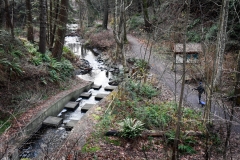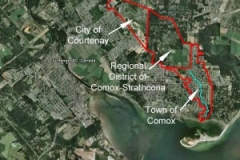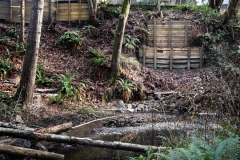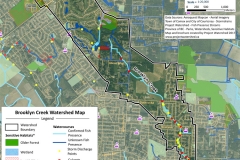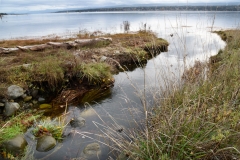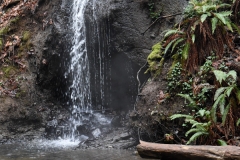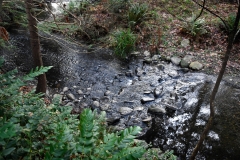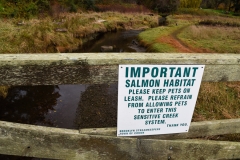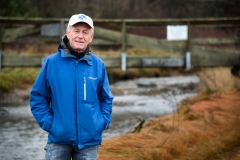Regional district staff recommend approving an amended application for groundwater extraction in Merville as a “home occupation,” but rural area directors want more clarity on its legal definition

Has engineered stormwater doomed BC’s waterways?
Courtenay Councillor Wendy Morin (left) and Comox Councillor Stephanie McGowan listen to Tim Ennis speak about Kus Kus Sum / George Le Masurier photo
Has engineered stormwater doomed BC’s waterways?
As population growth continues unrestrained and subsequent urban development expands the dimension of impervious surfaces, an increasing volume of polluted stormwater runoff will poison British Columbia’s waters, local species and natural ecosystems.
It sounds like a doomsday prediction, and according to the keynote speaker at a recent provincial conference on water stewardship it’s going to take a major change in local government thinking to avert this disaster.
Bill Derry, one of the Pacific Northwest’s best known experts on stormwater management, delivered this keynote message recently to an audience of more than 200 British Columbia streamkeepers, local government engineers and elected officials and others. Derry spoke April 3 at the second Vancouver Island Symposium on water stewardship organized by The Partnership for Water Sustainability in B.C.
“Put the forest back”
Before any development occurred in B.C., soils and natural vegetation in forests soaked up rainwater, filtered it and slowly released it into streams that flow into larger bodies of water. But in cities, where nature has been covered with impermeable surfaces, rainwater flows along streets where it picks up toxic chemicals and carries them unfiltered into water systems through gutters and underground pipes.
To protect or restore water quality in developed areas is a complicated problem, but Derry said the solution is quite simple: “Put the forest back.”
That’s impossible, of course, yet alternatives do exist.
Fifty years ago, Scottish landscape architect Ian McHarg proposed using natural systems in urban planning. His 1969 book Design With Nature was a guide toward what we call green infrastructure today; the use of rain gardens and infiltration galleries.
Getting local government engineers to implement green infrastructure that protects or restores water quality in developed areas will take massive and relentless public pressure on local governments.
“Tweaking current systems and practices isn’t enough,” he said. “Major change is required, and governments can’t do it. They won’t do it unless we push them.”
Derry said government engineers and elected officials are reluctant to shift from managing stormwater with curbs and gutters toward source control — managing rain where it falls — out of fear of lawsuits and insurance liabilities.
And local governments don’t believe people will maintain rain gardens or other green infrastructure on their properties, he said.
“So we have to challenge old ideas at chamber forums and talk to decision-makers,” he said. “Change will only and always comes when motivated people talk to other people.”
Derry was one of several speakers at the conference who spoke of the benefits of designing municipal systems that attempt to mimic nature. Others spoke of studies that show green spaces and urban streams improve people’s mental health, and are aesthetically pleasing.
Jody Watson, supervisor of environmental planning and initiatives for the Capital Regional District, echoed Derry’s message that public pressure can effect change. Watson is also the past chair of the Bowker Creek Initiative, a successful restoration of a major waterway running through three municipalities in the Victoria area.
Because local governments had given up on Bowker Creek, more and more of it was being buried and channelized.
But widespread community pressure raised the creek to the regional district’s No. 3 priority. Consultants had to convince local engineers of the value of restoring and daylighting the creek. Some staff engineers had rigidly opposed daylighting the creek.
“Sometimes you have to just wait for somebody to retire,” Watson said.
Derry urged conference attendees to champion better stormwater practices on several fronts.
— No expansion of urban growth boundaries. Increase urban density and “save the best of the rest,” he said.
— Require government agencies to preserve forests, not just slow down development. “There should be no net loss of forest cover,” he said.
— Ban toxins such as zinc on vehicle tires, copper on brakes, phosphorous and the micro-plastics from single-use bags and water bottles at the local, provincial and federal level.
Deery cautioned his audience not to expect instant results.
“This isn’t something that will happen overnight,” he said. “But we need to amp up the seriousness of the discussions.”
COMOX LAKE, CONSERVATION PARTNERSHIPS AND BROOKLYN CREEK
Comox Valley Regional District Senior Engineer Marc Rutten spoke to the conference about the Comox Lake Watershed Protection Plan. It’s a wide-ranging effort that involves multiple landowners and will address issues of turbidity and hydrological changes from logging activities. The watershed is the only source of drinking water for 50,000 residents.
Tim Ennis, the executive director of the Comox Valley Land Trust, spoke about the Comox Valley Conservation Partnership, one of six such groups in the province. The partnership has a unique focus on local government, and speaks with one voice on conservation issues, growth and urban forest strategies. Ennis also talked about the Kus-Kus-Sum project, which he said is more about reconciliation than restoration. “Ten acres of steel and concrete is a daunting” restoration project. But he called the recovery of the K’omoks Estuary a “fantastic model for success.”
Al Fraser and Marvin Kamenz of the Town of Comox, and Christine Hodgson of the Brooklyn Creek Watershed Society, spoke about the relationship between the town and the streamkeepers. Hodgson said over the last 13 years, the streamkeepers have raised about $300,000 ($100,000 in-kind) for in-stream work to improve fish habitat. The town has roughly matched the group’s fundraising. The streamkeepers also do annual smolt counts and public education for neighboring residents.
SUBSCRIBE TO OUR NEWSLETTER
On Merville groundwater extraction it’s deja vu all over again
Merville water bottling issue returns to the CVRD, highlights provincial water policies
The Comox Valley Electoral Areas Service Commission will consider on Monday an amended application for water bottling operations in Merville and draw attention to larger water policy issues in British Columbia
What’s dire: the lack of Comox subdivisions or climate change and gradual deforestation?
A Comox Valley developer is suing the Town of Comox because his permits to cut down trees and build more single-family homes haven’t been issued as fast as he’s wanted and because the town wants a wider walking trail through the property
Join the discussion Oct. 3 about food system security in the Comox Valley
The Watershed Sentinel magazine is hosting a zoom webinar Oct. 3 on food system security in the Comox Valley
Comox Valley Nature webinar to discuss effect of climate change on marine life
Comox Valley Nature lecture to discuss how this summer’s heatwave killed off billions of sea life and the future for marine ecosystems








